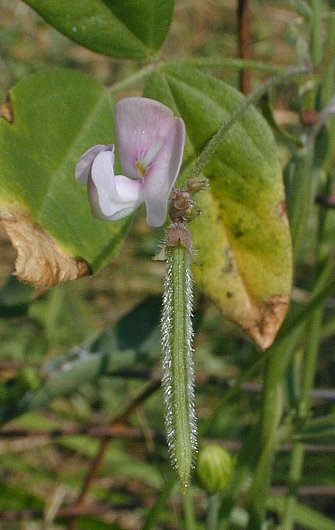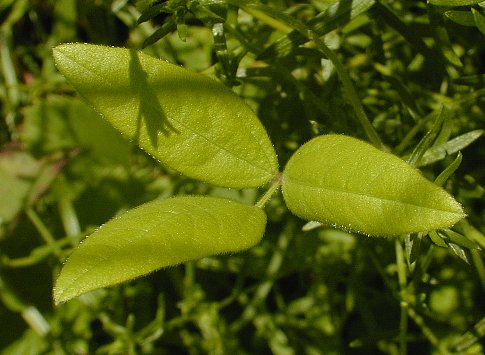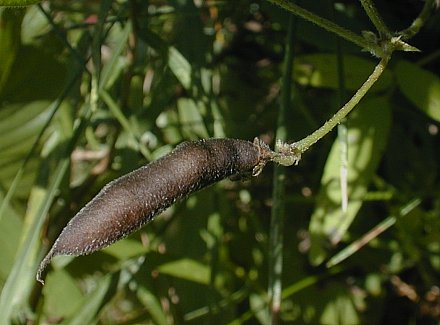 Description:
This herbaceous vine is a summer annual about 2-6' long that branches
occasionally. Its slender stems can climb by twining about adjacent
vegetation; they are finely pubescent. Alternate trifoliate leaves
occur at intervals along the stems. Each leaflet is about 1" long and
1/3" (8 mm.) across; it is oblong-lanceolate, smooth along the margins,
and
finely pubescent on both the upper and lower sides. Each trifoliate
leaf has a long petiole about 1-2" long that is also finely pubescent;
there is a pair of small lanceolate bracts at the base of each petiole.
No tendrils are produced by this vine. At the base of the middle to
upper leaves, a slender flowering stalk (peduncle) about 1-4" long is
occasionally produced. Each stalk terminates in a dense cluster of 1-6
small flowers; usually only one flower in a cluster is in bloom at a
time. Each flower is up to ¼" long; it has a pale pink to purplish pink
corolla. This corolla has a typical pea-like structure that consists of
a standard, keel, and enclosing wings. However, the narrow keel and its
wings are somewhat unusual in that they curve upward in front of the
standard, instead of remaining straight. This characteristic
distinguishes the Strophostyles genus from many
other members of the Bean family. The short tubular calyx of each
flower is light green to purple and finely pubescent; it has 4-5
shallow teeth along its rim and a pair of small bracts (bracteoles) at
its base. The pedicel of each flower is very short. The blooming period
occurs from late summer into the fall and lasts about 1-2 months. Each
flower is short-lived and lacks any noticeable floral scent. A fertile
flower is replaced by a cylindrical seedpod about 1–1½" long that has a
beaked outer tip. This seedpod is initially green, but becomes dark
brown with maturity; it is finely pubescent to conspicuously hairy.
Each seedpod contains a few large seeds that are oblongoid in shape;
they become dark, shiny, and hairless with maturity. The root system
consists of a taproot. This vine spreads by reseeding itself.
Description:
This herbaceous vine is a summer annual about 2-6' long that branches
occasionally. Its slender stems can climb by twining about adjacent
vegetation; they are finely pubescent. Alternate trifoliate leaves
occur at intervals along the stems. Each leaflet is about 1" long and
1/3" (8 mm.) across; it is oblong-lanceolate, smooth along the margins,
and
finely pubescent on both the upper and lower sides. Each trifoliate
leaf has a long petiole about 1-2" long that is also finely pubescent;
there is a pair of small lanceolate bracts at the base of each petiole.
No tendrils are produced by this vine. At the base of the middle to
upper leaves, a slender flowering stalk (peduncle) about 1-4" long is
occasionally produced. Each stalk terminates in a dense cluster of 1-6
small flowers; usually only one flower in a cluster is in bloom at a
time. Each flower is up to ¼" long; it has a pale pink to purplish pink
corolla. This corolla has a typical pea-like structure that consists of
a standard, keel, and enclosing wings. However, the narrow keel and its
wings are somewhat unusual in that they curve upward in front of the
standard, instead of remaining straight. This characteristic
distinguishes the Strophostyles genus from many
other members of the Bean family. The short tubular calyx of each
flower is light green to purple and finely pubescent; it has 4-5
shallow teeth along its rim and a pair of small bracts (bracteoles) at
its base. The pedicel of each flower is very short. The blooming period
occurs from late summer into the fall and lasts about 1-2 months. Each
flower is short-lived and lacks any noticeable floral scent. A fertile
flower is replaced by a cylindrical seedpod about 1–1½" long that has a
beaked outer tip. This seedpod is initially green, but becomes dark
brown with maturity; it is finely pubescent to conspicuously hairy.
Each seedpod contains a few large seeds that are oblongoid in shape;
they become dark, shiny, and hairless with maturity. The root system
consists of a taproot. This vine spreads by reseeding itself.
Cultivation:
The preference is full or partial sun, mesic to dry conditions, and
sandy soil. Conventional garden soil containing loam or clay-loam is
tolerated if there is not too much competition from taller plants. The
seeds may remain in the ground for several years before they germinate;
scarification of the seeds can speed up this process. The roots add
nitrogen to the soil by forming a symbiotic association with rhizobial
bacteria.
Range & Habitat:
The native Small Fuzzy Bean occurs occasionally in southern Illinois
and in sandy
areas of central and northern Illinois, otherwise it is uncommon or
absent (see Distribution
Map). Habitats include open rocky woodlands, open sandy
woodlands, sandy savannas, glades, thickets, sand prairies, and sandy
fields. This species is usually found in rather dry areas with sparse
ground vegetation. Occasional wildfires are probably beneficial in
removing competition from woody vegetation and other tall plants.

Faunal
Associations:
The nectar of the flowers occasionally attracts bees, including
bumblebees, Leaf-Cutting bees (Megachile spp.), and
Dagger bees (Calliopsis spp.). The extra-floral
nectaries attract ants and Halictid bees. The caterpillars of the
following skippers occasionally feed on the foliage of Strophostyles
spp. (Fuzzy Beans): Epargyreus clarus
(Silver-Spotted Skipper), Thorybes bathyllus
(Southern Cloudywing), and Urbanus proteus
(Long-tailed Skipper). Some leaf beetles feed on the foliage as well,
including Cerotoma trifurcata (Bean Leaf Beetle), Sumitrosis
ancoroides, and Sumitrosis pallescens;
the larvae of the latter two species are leaf-miners. The Mourning Dove
and Bobwhite Quail eat the seeds of Fuzzy Beans, while the foliage is
readily eaten by cattle, deer, and other mammalian herbivores.
Photographic Location:
The wildflower garden of the webmaster in Urbana, Illinois. The dainty
foliage of Aster oblongifolius (Aromatic Aster) can
be observed in the background of the photographed trifoliate
leaf.

Comments: This rather ordinary-looking vine has small flowers that are short-lived. Other common names for this species are Small Wild Bean and Small Woolly Bean. Two other vines in this genus that occur in Illinois are the following: Strophostyles helvola (Large Fuzzy Bean) and Strophostyles umbellata (Perennial Fuzzy Bean). As the common name implies, Large Fuzzy Bean is a more robust vine with longer stems and larger leaves; the leaves of this species are sometimes lobed. It is also a summer annual, but prefers more moist habitats. Similarly, the Perennial Fuzzy Bean is more robust with longer stems and larger leaves; this perennial vine is restricted to southern Illinois. These latter two species have slightly larger flowers (greater than ¼" in length) than the Small Fuzzy Bean (up to ¼" in length); they all have keels on their flowers that curve upward and their seedpods are finely pubescent to conspicuously hairy. While the mature seeds of Small Fuzzy Bean are shiny and hairless, the mature seeds of Large Fuzzy Bean and Perennial Fuzzy Bean are usually mealy-pubescent.